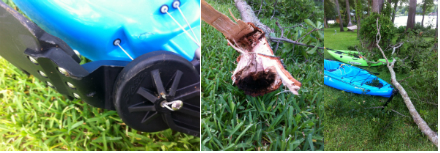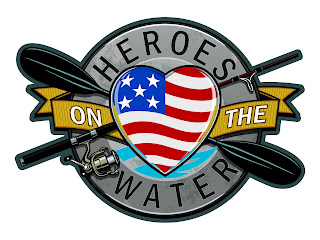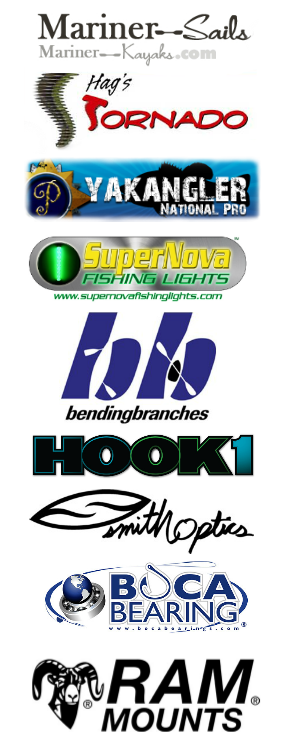by Robert Field
The day
before Independence Day I set out for a four day kayak fishing excursion to the
Texas coast. I would end up pushing my limits to the max, having a brush with
death, and catching some amazing fish in the process. This was an experience
that I will remember for the rest of my life. Here is my story…
I loaded up
the kayak and all of my fishing and camping gear and began the long journey
from Dallas to Corpus Christi, TX. I arrived after dark and drove along the
beach to my campsite. Straight off shore on the horizon I could see the
blinking lights of my destination: the Mayan Princess oil rigs. I set up camp
near the water and climbed into my tent, thinking of nothing but the adventure
that lied ahead.
Day 1
When I awoke
the conditions were ideal: the surf was flat, the wind was calm, and the water
looked like glass beyond the breakers. I was amazed at the beauty of this
place; it was not at all what I think of when I hear “Texas coast”. The sand
was white, the water green and clear, and hardly any seaweed in sight. At
around 7:00 AM the guys I was meeting began to arrive so we loaded up our
kayaks and set off into the surf.
 |
| Man O War |
The three
mile journey to the oil rigs could only be described as pleasant and serene. I
saw a piece of trash floating in the water so I pedaled over to grab it and throw
it in my kayak. My hand stopped inches above the bag when I realized it was not
a bag but a huge Man o’ War. I looked up and realized they were everywhere.
Needless to say, I elected not to go for a swim that day.
I was trolling
on the journey out, and as I approached the first rig, BOOM one of my reels
starts screaming as the line peels
off the reel. I grabbed the rod, tightened the drag, and held on for the ride.
The water clarity this far out was simply incredible. A half hour into the
fight, I looked down and could see a beautiful shade of yellow and gray over 20
feet below me.
 |
| Jack Underwater |
I had hooked
into a gorgeous Jack Crevalle. This thing put up an incredible fight. I pulled
it up into the boat and was grinning from ear to ear. I had landed my first
deep sea fish from the kayak, and it felt amazing.
 |
| Jack Crevalle |
When I
arrived at the first oil rig, I was blown away by how massive it was. It is
daunting looking up at such a gigantic structure while sitting a couple inches
off the water. I tied off to the oil rig and dropped down some bait. Over the
next hour I ended up landing several red snapper.
 |
| Red Snapper |
As the sun
beat down, fatigue began to set in, so I headed back to shore. I hung out on
the beach for the rest of the night with my mind going a hundred miles an hour.
Our target the next day was the formidable King Mackerel, or Kingfish. I dozed off under the starry sky and dreamt
of the day ahead.
Day 2
As the sun
rose, I once again loaded up the kayak and headed out into the surf. This time,
I made the paddle alone. I had grown confident in the open water and all
anxiety had disappeared. I made it out to the oil rigs, but instead of tying
off, I trolled around the rigs, weaving in between the massive structures. Not
twenty minutes later, my rod bends over and the reel screams. Half an hour
later, I had my first King in the boat. These things are massive, powerful, and
have a mouth full of razor sharp teeth. What a rush!
 |
| First King |
I would end
up landing seven of these huge beasts. At one point, I had a fish on one rod
and as I was reeling in the other to keep them from tangling, that reel started peeling line and I
realized I had a double! I tried my best to juggle both rods, but would end up
having one of them spit the hook. I did land the first one after an epic battle
over 40 minutes, and it was a monster.
 |
| Massive King |
A pod of
porpoises was hanging out with us all day long. Some of the guys said they’ll
take the fish right out of your hands on the side of the boat if you’re not
careful. It was really cool getting to hang out with these extremely
intelligent animals all day.
 |
| Dolphins |
 |
| More Dolphins |
The bite
slowed down so I decided to head in a little after lunch. I had a long drive
ahead of me to my next destination. Before I left Dallas, I had asked everyone
I know where I could go to have the best chance of catching a big shark from
the kayak, and everyone had the same answer: Galveston, TX.
Day 3
Where
everything went absolutely perfect in Corpus Christi, everything began to go
downhill as soon as I arrived in Galveston. I pulled onto the beach and before
I made it ten feet my Jeep got stuck. An hour later I finally freed it and
pulled up onto the firmer sand near the water. By now it was late, so I set up
camp and fell asleep immediately. In the morning, I would be hunting sharks.
I awoke suddenly
at about 3:30 AM to what I thought was somebody kicking my tent. I jumped out
quickly, ready to defend myself, and landed in shin-deep water. The tide had
come in further than I expected and my tent was sitting in a foot of water! I
threw it in my Jeep, jumped in, and decided to just go sleep in my car in front
of the bait shop until they opened.
I woke up,
bought bait, and headed back to the beach. Unlike my trip to Corpus, I had
nobody to meet up with on this trip. As I looked out at the ocean, I thought
“We are NOT in Corpus anymore.” The water was chocolate brown, the beach was
dirty, and there was a wall of seaweed three feet high all along the water’s
edge. Well, this is where the sharks were, and I wasn’t there to sight-see, so
I loaded up the kayak and headed out into the murky water alone. I paddled almost
a mile out, dropped my anchor, rigged up my bait, and set my lines out.
Before long,
one of my floats disappears and as I look over at my reel, sure enough it goes off. “This is it!” I thought. I tightened down the drag in an effort to
stop the fish, but it was not slowing down. This thing was FAST. I realized
that I was running out of line on my reel, and if I got to the spool it was all
over. I made the executive decision to release from my anchor and go along for
the ride. This would end up being a grave mistake.
The fish
took off straight in the one direction I did not want to go. About a quarter
mile downwind from where I was anchored was Rollover Pass. This is an area with
extreme currents, and if I were to get sucked into it I would almost certainly
be killed. I tried with all my might to turn the fish around but it would not.
Finally he decided he wanted to head off shore, and I felt an overwhelming sense
of relief as he pulled me out to sea.
Half an hour
later, I got a glimpse of my first shark from the kayak. It was a beautiful 5-foot
Blacktip shark. It was not the monster I was after, but this was a moment I had
dreamt of since the day I bought my first kayak and I cannot begin to express
the feeling that overcame me. I admired him for a bit, got him on video, and
released him to fight another day.
 |
| First Shark from the Kayak |
 |
| Smile! |
 |
| My What Lovely Teeth You Have! |
I suddenly
realized I was almost a mile from where I left my anchor. It had a small orange
float at the end of the rope, but the conditions had suddenly gotten worse as I
was fighting the shark, and the swells were now over my head. Finding this
thing was going to be a challenge. I spent the next two hours pedaling into the
wind and against the current, searching a vast ocean for a tiny orange float. I
could not continue fishing without an anchor; the current and wind were too strong.
Exhausted, defeated, and overwhelmingly disappointed, I decided to call it a
day. As I turned to head in, sure enough, there
it is! I was overcome with excitement as I pedaled over to it. I learned
the hard way on this day, if you stop paying attention for one second, your
whole world can get turned upside down. Literally.
 |
| Man Overboard |
A HUGE wave
crashed into the side of my boat as I was looking the other way at the anchor
float. This was my first time ever flipping the kayak in deep water. I am now
swimming in arguably the most shark infested waters in Texas, a mile out to
sea, with nobody around to hear me scream. I cannot tell you what that feels
like; it was a feeling unlike any I’ve ever felt before. I looked up and
realized my kayak was floating away from me in a hurry. I swam for my life and
managed to catch it. I swam around to the front of it and tried to flip it
over. Not even close. I swam around to the back and again attempted to right my
boat. It wouldn’t even budge. This is when the panic really began to set in. I
tried my best to keep my composure and think logically. Then it hit me. I swam
around to the side of the kayak and climbed up onto the bottom of it. I grabbed
the opposite side, and threw my whole body backwards with every ounce of force
I could muster. Sure enough, the boat flipped over. “Thank God,” I thought. I tried to pull myself up into it, but as I
did the boat began to flip back over. I let go. I looked up and realized I was
drifting straight for Rollover Pass. I was now less than 300 yards from where
it started. It was time to make a decision. Either abandon the kayak and swim
for shore, or stick with it and risk getting sucked into the pass. I decided I
was not letting my new boat go, so I gave it one more shot. I threw my body across
the boat and clambered in. I quickly turned and headed away from the pass. I
had made it.
 |
| OJT Deep Water Re-entry |
At this
point, I decided I should probably call it a day. I rode the waves all the way
onto the beach. Some people came over and asked me how I did, and as I began to
tell them my story, three men ran up to the beach screaming “Whose kayak is
this?!” I walked over and told them it was mine, and they all let out a sigh of
relief. They told me a helicopter was en route, an ambulance was pulling up,
and they were launching a boat as we speak. It turns out that a lady who owned
a small shop that sells seashell necklaces had watched me flip through a pair
of binoculars and had called the coast guard. She potentially could have saved
my life that day. I got a chance to thank her later that day.
 |
| Coastguard |
A family
that watched the whole event unfold was kind enough to offer to let me spend
the night in their RV as they were heading back home that night. I must have
said no a hundred times, but they insisted. These people didn’t know me from
Adam yet after a few hours of hanging out they trusted me to stay in their home
away from home. I cannot say enough about the Meyers, and if any of you are
reading this, know that I will never forget you and the kindness you showed me.
For the first time in four days I got to shower and hang out in some A/C. It
was an amazing end to an epic day. I reflected on the day’s events as I dozed
off to sleep.
You know
that voice that tells you when to just let it go? Apparently mine is taking the
summer off, because I fell asleep with plans to head out first thing in the
morning to give it one more shot. Once again, my judgment and decision making
would cost me…
Day 4
I awoke the
next morning before sunrise and walked outside towards the beach. I was
immediately blasted by a very strong
south wind. It was dark, but I could still clearly make out the huge breakers
crashing into the beach. The conditions were significantly worse than the day
before. “Well, I’ve come this far, I’m not going to give up now,” I foolishly
thought to myself. I loaded up, dragged the kayak onto the beach, and set out
into the surf. The waves I encountered were unlike anything I have ever
experienced. A few times I vaulted over four-foot waves so hard that my kayak slammed down onto the water behind them.
Once I made
it past the breakers, it was not much better. I decided to stick closer to
shore this time, and dropped my backup anchor about 400 yards off the beach. I
began to get an eerie feeling as I realized that not a single person was on the
beach. If something went wrong this time, nobody would be watching with
binoculars. I looked to my right and noticed a huge storm system off in the
distance. I did not know it at the time, but a small tropical storm was due to
land in Galveston around lunchtime. What I also did not realize was that I had
unscrewed the drain plug in my kayak the night before to get some of the water
out of it from when I capsized, and had forgotten to screw it back in before I
headed out. I was out in the roughest seas I’ve ever been in, alone, and was
taking on a lot of water without the slightest clue that it was happening.
Well, somebody must have been watching over me. Within five minutes of dropping
my bait in the water, an enormous wave crashed down right on top of me and
broke my anchor rig. I watched the float slide off the rope, and the anchor
rope slipped into the murky water. It was over. I could not fish in these
conditions without an anchor. I was disappointed, but I would later find out
this was a blessing in disguise. I reeled in my rod, secured my gear, and
headed in as I watched the mountainous waves crash between me and the beach. I
managed to successfully surf the first three or four waves that picked me up
from behind, but then suddenly I heard a crash and the hairs on the back of my
neck stood up. I knew it was bad. I turned around and two waves were crashing
into me from two different angles. SWOOSH.
 |
| Cross Checked On The Way In |
 |
| More Swimming |
 |
| The View From Below |
As my head
broke the surface and I gasped for air, another huge wave crashed into my kayak
and slammed it into my forehead. Dazed, I somehow managed to hang on to the
boat. I was now getting pounded by waves while hanging onto my kayak for dear
life. I was still about 100 yards from shore and could not touch the bottom.
Somehow I managed to flip the kayak over with the method I had learned the day
before, and stayed in it long enough to make it to the beach. As soon as I
stepped foot on the sand, I fell to my knees and collapsed. My head was
pounding and I felt extremely dizzy. I laid down in the sand as half of my gear
washed up onto the beach. As I laid there, six words escaped my mouth: “You win
this time, Mother Nature.” When I eventually opened up my hatch to look inside
my kayak, about four gallons of water was sloshing around inside. That was
after being out there for 10 minutes. I would have sunk in less than an hour
had I stayed. My anchor breaking off was the luckiest thing that happened to me
all weekend.
This trip
was one of the most incredible journeys of my life. There were great moments, terrifying
moments, amazing accomplishments, and many lessons learned. My only hope is
that at least one kayaker reads this and learns from a few of my mistakes. I
should never have gone beyond the breakers alone in those conditions. I learned
that no matter what situation you find yourself in, you have to always keep a
level head and think things through before you act. The ocean is a powerful
force and your situation can turn on you in a split second. I realized that I
need to give somebody a float plan before I head out, so that if something
happens to me there is somebody who knows where I am heading and when I should
be back. I learned that despite how badly you want to do something, sometimes
you have to call it off and wait for a better day. No fish is worth dying for.
As you can
see, I had my video cameras rolling the entire time. I will be producing an
epic three-part film series from my trip. Trust me, you DO NOT want to miss it.
Subscribe to my YouTube channel at www.youtube.com/YAKnAGGIE
so you can catch the action when it airs.
In the
meantime, I’ll be gearing up for the next adventure…
Also, COMING SOON…
We will be
launching our new website, www.YakFishTV.com.
This will be a site dedicated to kayak fishing films, but will also have
sections for blog posts, product reviews, a photo gallery, and much more. We
will be recruiting 4-5 kayak anglers with a knack for videography to join the
YakFish TV team so that we can consistently
produce quality kayak fishing adventures for you to enjoy. If you would like to
apply to become part of the
YakFish TV
team, send a sample video to
[email protected].
________________________________________________________________________
Thanks to Robert for sharing his story of triumph and trials. He knows there is a lot to be learned here and I plan on revisiting it later in the week. If you haven't subscribed to his YouTube channel, you should do that. Look for YakFishTV very soon and if you fancy yourself as a filmmaker, think about applying to the team.
-----Chris
 Tracks- $10-$50- Some kayaks come with it already, some don't. These are or at least can be the base for all attachments. These also allow you to strip off attachments before transport. I use the YakAttack GT175 heavy duty tracks. Tracks come in all shapes and sizes so finding one that fits your needs is fairly easy.
Tracks- $10-$50- Some kayaks come with it already, some don't. These are or at least can be the base for all attachments. These also allow you to strip off attachments before transport. I use the YakAttack GT175 heavy duty tracks. Tracks come in all shapes and sizes so finding one that fits your needs is fairly easy.  12 Volt Battery- $20-$30- Lots of ways to do this one but the easiest and most common is a deer feeder battery. 7.5A and rechargeable. Why do you need this? To power the next thing on the list!
12 Volt Battery- $20-$30- Lots of ways to do this one but the easiest and most common is a deer feeder battery. 7.5A and rechargeable. Why do you need this? To power the next thing on the list!



































